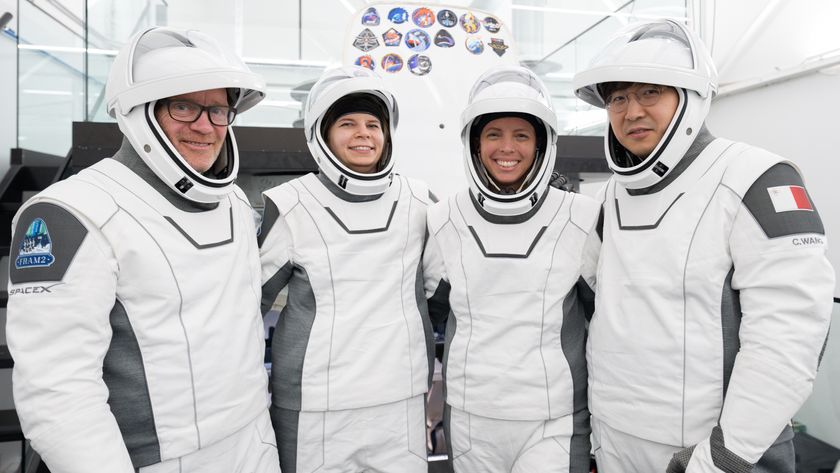Viking 1: First U.S. Lander on Mars
Viking 1 was the first American spacecraft to touch the surface of Mars, and the first spacecraft ever to remain there for the long term. It followed a series of short-lived Soviet probes that either landed or crashed into the surface in the decade before.

Its successful landing on July 20, 1976, provided a window into climatic conditions on the red planet. From Viking 1's perch on Chryse Planitia, the lander spent six years beaming pictures, information and even life experiments back to Earth. Its life results are still being debated today.
An ambitious project, scaled down
NASA originally planned to head to Mars with an ambitious program called Voyager (not to be confused with the Voyager 1 and Voyager 2 probes that eventually soared to the outer edges of the solar system.)
The agency proposed to use the Saturn V rocket — once used to hoist astronauts to the moon – to send Voyager to Mars. An orbiter would circle above as a lander touched the surface, where it would remain on the surface for at least a Martian year (two Earth years) to observe the changing seasons. Project costs were estimated to be as high as $2 billion in 1970s dollars.
"I guess our eyes were too big for the budget there," said Edgar Cortright in a 1998 NASA oral history. He held a series of senior human spaceflight positions at NASA in the 1960s before becoming director of the Langley Research Center between 1968 and 1975.
"There was a money crunch at the time," he added. "We were lucky to get the money to do Viking, and that was a struggle."
The mission concept was scaled back to two orbiters and two landers, launching on smaller rockets and designed to stay on Mars for 90 days. NASA estimates the cost was about $1 billion (in 1970s dollars) for the entire Viking project.
Viking 1 launch and landing
Viking 1's Titan III-E rocket roared to life Aug. 20, 1975, as the spacecraft set forth on its nearly 500-million-mile journey to Mars. Fully fueled, the orbiter-lander duo weighed about 7,800 pounds. Viking 1's twin, Viking 2, went into space on Sept. 9, 1975.
Viking 1's lander was supposed to touch down on Mars on July 4. But as the spacecraft drew closer to Mars and began taking pictures of the landing site, the Viking 1 team worried about the spacecraft's chances of making it safely to the surface.
The prime landing site at Chryse was based on looking at Mariner 9 pictures, which were taken in lower resolution. Viking 1's view of the site showed the opposite of what planners wanted: "a deeply incised river bed," according to On Mars, a NASA History Office publication detailing the early Mars missions.
Complicating matters was the fact that the landing date of July 4, 1976, happened to coincide with the bicentennial celebrations of the United States' founding. Viking 1 was supposed to be a part of that, but of course, safety needed to be the primary consideration.
Mission planners voted to extend Viking 1's landing date until a more suitable landing site could be found. They debated between a few sites and voted on July 12 for a location in Chryse Planitia, about 365 miles (575 kilometers) west of where the lander was supposed to go.
Viking 1's orbit was adjusted on July 16, and the spacecraft touched down safely on July 20, 1976. On that day, only seven years before, man stood on the moon for the first time.
Six years of science observations
Each Viking mission was only supposed to last 90 days after landing, but the landers and orbiters actually lasted for years. Their images and data on Mars would define our view of the planet for the next couple of decades.
From orbit, the Vikings provided a window into Mars' tumultuous past. They took pictures of volcanoes and also imaged ancient channels where floods may have roared in ancient history. The cameras peered closer at the vast Valles Marineris, a 2,500-mile rift across Mars' equator, taking snapshots of landslide sites and craters.
As for the Viking 1 lander, it sent back its first image of the surface just moments after landing, and took thousands more for scientists to process over its lifetime. Besides a seismometer experiment that refused to deploy properly, and early problems with a sampler pin, the experiments on board the lander remained healthy through its last day of transmissions on Nov. 13, 1982.
Viking 1's results showed scientists a few surprises. There were a lot of rock types at its landing site, indicating that they probably had different origins. Day-to-day weather conditions on Mars were usually consistent, although there were seasonal variations. Winds were higher speed during the day and tended to die down at night. The lander detected magnetic particles in the soil, although scientists could not fully describe what the soil was made up of.
These results were important as they hinted at what a human would experience when walking upon the Red Planet. Dust storms, radiation and weather conditions are all things that will need to be considered when humans choose to make the journey to Mars.

Did Viking 1 find life?
Perhaps no other life experiment has come under as much scrutiny as those aboard Viking 1 and its sister craft, Viking 2. The landers had rudimentary tools on board to search for life. The results they dug up in the 1970s were widely seen as proof that no life was detected. However, studies in the past few years have cast that finding in doubt.
The life-detection experiment was actually in three parts, but the part that is under the most debate is one that was seeking microorganisms in Martian soil. Viking 1 picked up a handful of Martian soil, heated it up to 932 degrees Fahrenheit (500 Celsius), and then checked out the dirt for any sign of organics. Neither Viking 1 nor its sister found organic compounds.
But a flurry of questions has come up about those results in the decades since then. Were the experiments sensitive or suitable enough to find life? Were the findings enough to dismiss life's existence?
Researchers in 2006 duplicated the experiments using Mars-like environments on Earth (such as an Antarctic dry valley and the Chilean desert) and detected organic compounds at levels not visible to the instrument, suggesting that life could have been hiding there all the time.
A 2010 study theorized Viking could even have destroyed the organics before detecting them. Researchers went on the assumption that Viking's landing sites had perchlorate, a substance discovered in the 2008 Mars Phoenix. The scientists took Mars-like soil known to contain organics and injected it with perchlorate before heating it.
After heating, the results showed chloromethane and dichloromethane, which are the same results that Viking produced. The key here is organics tend to break down into those substances when heated, meaning any organics could have been destroyed in the experiment.
Organics are not in themselves proof of life, but it's a key indicator here on Earth. Researchers will continue the hunt for organics on the Mars Curiosity mission currently roaming the red planet. It should be noted, though, that Mars Curiosity is not designed to find life. It instead is looking for evidence of habitability in the past or present.
— Elizabeth Howell, SPACE.com Contributor
Related:
Join our Space Forums to keep talking space on the latest missions, night sky and more! And if you have a news tip, correction or comment, let us know at: community@space.com.
Get the Space.com Newsletter
Breaking space news, the latest updates on rocket launches, skywatching events and more!

Elizabeth Howell (she/her), Ph.D., was a staff writer in the spaceflight channel between 2022 and 2024 specializing in Canadian space news. She was contributing writer for Space.com for 10 years from 2012 to 2024. Elizabeth's reporting includes multiple exclusives with the White House, leading world coverage about a lost-and-found space tomato on the International Space Station, witnessing five human spaceflight launches on two continents, flying parabolic, working inside a spacesuit, and participating in a simulated Mars mission. Her latest book, "Why Am I Taller?" (ECW Press, 2022) is co-written with astronaut Dave Williams.












